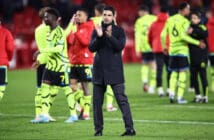The ambience of an empty stadium presented the perfect backdrop to hear the rattles of two cogs whirring against each other.
On Tuesday evening, the two complex minds of Ralph Hasenhuttl and Mikel Arteta were interlocked in a tactical masquerade.
Subplots, smokescreens, deceptive nuances and false pretences that baited the other. What transpired on the touchline was a game in itself.
Perhaps this was always going to be the case. Commencing battle for the second time in four days was inevitably going to mean a prolonged, intensive period studying the intricacies of the opposing foe.
It allowed more time to heed the warnings of the man standing in the next technical area, adjusting and modifying Saturday’s Plan A with a more thorough and extensive breakdown to bring the second time round.
Arteta adjusted and altered Arsenal’s blueprint. They had been too quiet and too timid at the weekend so needed the requisite bravery to go toe-to-toe with Hasenhuttl’s Southampton. David Luiz was brought in and soon set about becoming Arsenal’s on-pitch radio. This was just one the multiple subplots in Arteta nudging his team to lead the dance. He knew Hasenhuttl also wanted to step foot on the dance floor first. This was going to be a intellectually exhausting duel.
On reflection of Arsenal’s victory, games like the one we saw on Tuesday night are often referred to as a ‘chess match.’ A phrase to describe the quiet tempest of a particular 90 minute passage. In other words, not a lot happened above the surface, but bubbling away in the undercurrent, a whole load of intangibles did occur.
But please let this writer tell it to you straight. Most of the time that is mumbo jumbo. A rhetoric that circles itself in riddles. And also, chess is a slow board game that relies upon slow and subtle moves – a further paradox that separates itself from the narrative of football.
In fact, Southampton versus Arsenal could only have been further away from chess if had been staged in the very deep depths of Mount Moco, Angola, and Sammy the Saint had been reffing.
Instead, it was fast and furious, with very blatant moves and hoaxes to lure the other to cash their chips in first.
The pitch was churned and sopping of the south coast rain after the short turnaround in matches did little to improve the surface conditions. What transpired after the initial downpour only added to the magnetism of two manager’s whizzing minds.
So what did happen? And what had changed in the wake of Saturday’s FA Cup match?
This writer opines and thereby presents to you, the reader, a few theories:
1. Out-Southamptoning Southampton:
From the first whistle, Arteta and Luiz were effervescent and fervent in their approach, a notable amplification to Saturday’s sounds. Like a flock of circling vultures, the pair incited Arsenal’s three-pronged attack to press high and set traps, as shown here in the lead-up to their opening goal.
The body position of Alexandre Lacazette closes off the passing lane back to Alex McCarthy. Note the arch of the Frenchman’s run, forcing Stephens into an uncomfortable position for a right-footed centre back playing on the left.
The other three Arsenal players are all on the front foot and anticipating a pass going into their assigned Southampton player. The paucity of a receiving outlet limits the passing lanes of Stephens.
2. Targeting Southampton’s stand-ins:
Ralph Hasenhuttl was without 75 percent of his first choice back four and Mikel Arteta had made no disguising the crux of the weakness.
Kyle Walker-Peters and Ryan Bertrand are both proficient ball retainers, meaning they can continually provide passing angles in tight areas and keep the ball moving. With Jake Vokins and Yan Valery both coming into the team and understandably nervy, Arsenal set traps which forced Saints to play risky balls into central areas, as Stephens does in the aforementioned example.
Due to the high number of Arsenal bodies already in the offensive third, the turnover in possession means they are able to play quickly and incisively.
The out-to-in runs from both Arsenal wingers exposed the lack of understanding within the makeshift backline, with Nicholas Pepe and Bukayo Saka picking up pockets of space between the outside centre back and full back.
Note how both widemen are inside their full back and running directly towards the goal. On this occasion, the resulting pass from Granit Xhaka finds Pepe and the Ivorian equalises.
Like I said, this wasn’t a game of chess. Arteta’s positioning of his wingers was quickly identified by Stephens, who would soon tell Vokins to keep Saka on the outside, enabling Stuart Armstrong ample time to recover and offer double protection.
3. Midfield overload:
As this writer has alluded to in previous pieces, teams are beginning to cotton on to Southampton’s penchant for funnelling attacks into central areas. With Hasenhuttl’s men now depleted through injury, Arteta laid back the ever- swelling vulnerability of Saints to circumvent offensive play.
James Ward-Prowse and Ibrahima Diallo were industrial all night and worked hard to put out midfield fires. But at some point, against an Arsenal team that had Thomas Partey and Emile Smith-Rowe returning, the midfield pair were overloaded and unable to extinguish every single flame.
The example below is the seconds prior to Saka putting the visitors ahead. A long ball ricochets in midfield and Xhaka eventually picks up the second and third phase. With Hasenhuttl wanting the hub of the side to press players rather than protecting space, it leaves Arsenal’s front three all in the area between Southampton’s midfield and centre backs – what the Saints boss himself calls the ‘red zone’.
This causes one pass from Xhaka to take out the entire midfield and Yan Valery, who is caught too high up field and further highlighting the hypothesis that his future lies in a more advanced position.
Xhaka’s pass finds Lacazette who has already surveyed the developing picture and knows what he is going to do by the time the ball arrives. As Arteta pinpointed prior to the game, Lacazette knows Saka will be making a run from out-to-in. The striker plays a first time ball which reduces the precious seconds Vokins has to recover.
Another factor to spot is Stephens’ square-on position, which protracts his turning circle (he can’t turn and sprint as quickly) and is unable to recognise what is happening over his left shoulder.
Southampton’s high line also adds to the efficacy of this particular strategy.
4. Half-time Hasenhuttl responds:
Though Hasenhuttl traipsed down the tunnel at half-time having watched his side blow the lead, all was not lost at that point. Arteta had vividly laid his cards out on the deck and beckoned the Austrian into his next move.
Arteta was enticing the Saints boss into an extensive change of plan, knowing he was without favoured personnel and specifically the fortified protection of his first choice defence. The crevice between centre back and full back was widening and so too was the cavernous oceans of space in midfield.
What was Hasenhuttl’s response? A modification to the 4-2-2-2.
“Stuey come inside!” – Hasenhuttl responded by Arsenal’s midfield dominance. The versatile, chameleon-like functions of Stuart Armstrong meant Saints essentially formed a midfield three in possession and provided cover to Vokins (see his hand pointing in the direction he wants the pass in) who had begun to moonlight as a customary left winger – a more natural position for the 20-year-old.

The slight, subtle alteration brought better balance to the side, with the extra body in midfield lessening the threat of Arsenal on transition and the scything inwards run of the two wingers – think of the job Jordan Henderson has done when in midfield and protecting Trent Alexander-Arnold from dangerous 1v1 defensive situations.
The change almost works immediately. Diallo’s switch of play finds Vokins, who utilises his adept ball carrying capabilities and drives into the attacking half. Due to Armstrong’s starting position, the Scot is able to run into a pocket of space from the inside left position.
Armstrong then releases the ball to Theo Walcott, who hits a powerful effort straight at Bernd Leno.

Conclusion – The healthier, more intact cards won
Hasenhuttl’s last retort was to modify the areas in which Danny Ings was operating. But indicative of Saints’ current injury and external woes, the striker is still recovering from his bout of COVID-19 and was not able to emulate his usual propensity of being the trump card within the pack.
On the hour mark, Hasenhuttl told Ings to drift out to the left and become a quasi-winger. It was partly a knock-on effect of Armstrong moving inwards, but also a result of Arteta having the enviable luxury of Partey being back in the fold and mirroring every movement of Ings.
The high press from the forwards meant Arsenal screened passes into Ings and when some did reach him, they were not of the intended quality. All of which made for a frustrating night for Southampton’s star-man, grounded out by the surrounding tactical and personnel issues.
Nathan Redmond – one of two senior outfield players on the bench – came on for his first minutes since injury. Ibrahima Diallo moonlighted as a left back while Armstrong did something similar in the middle of the park.
Southampton ended up with five players under the age of 21 on the pitch and plasters covering up sunken holes.
“We know we are a good team when everything is perfect and in a good shape,” Hasenhuttl said afterwards. “We shouldn’t be too negative. We knew a situation like this can come.”
Two erudite managers were on display on Tuesday evening. But one ended up having more tricks up his sleeve to call upon.
Follow us on Twitter @ProstInt
![Prost International [PINT]](https://prostinternational.com/wp-content/uploads/2021/08/PINTtFontLogoRoboto1536x78.jpg)




1 Comment
Continued excellent analysis and insight on this site. Thanks